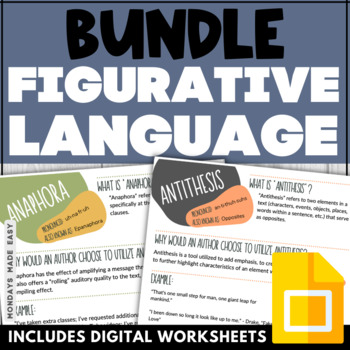Figurative Language Poster Bundle - 32 Literary Device Vocabulary Worksheets
- Zip
- Google Apps™

Products in this Bundle (3)
Also included in
- This AP Lang and Comp Bundle includes slideshow lessons and writing activities for teaching the synthesis essay, argumentative writing, rhetorical analysis, expository texts, and more. Included in this resource are several tasks, collaborative activities, projects and assessments to prepare studentPrice $100.00Original Price $131.30Save $31.30
Description
Reinforce literary analysis vocabulary with these figurative language posters! These posters double as figurative language worksheets by having students locate definitions and examples for each literary device term. Use their work to create a word wall anchor chart on your classroom bulletin board!
⚡️⚡️⚡️ Save over 30% with the bundled discount! ⚡️⚡️⚡️
Included with these Figurative Language Posters:
✏️ 32 Figurative Language Worksheets - Digital & Print
- These templates can be completed by students before displaying them on your bulletin board
✏️ Detailed Answer Keys with Figurative Language Examples
- Features diverse authors and examples from popular culture
- Answer key can also be used as ready-to-print figurative language posters
✏️ Figurative Language Posters in Color and Grayscale Format
✏️ Teacher Instructions for using this resource
How to use this Literary Device Vocabulary Activity:
These figurative language posters will solidify essential terminology to support your students during literary analysis. This vocabulary activity results in a useful classroom anchor chart to display these figurative language terms on your bulletin board.
These word wall worksheets can be used as either a collaborative activity or an individual assignment.
To use these activities as a collaborative activity, assign a term to each student or group of students. Students can use online resources to write a definition of the literary device and explain why an author would utilize this device. Then, they can draw from their background knowledge or find examples online to illustrate the use of each figurative language term. I find that when students apply their own examples from popular culture, these terms become easier to understand!
Once students have completed their figurative language poster, you can laminate these pages and display them on the classroom bulletin as a word wall anchor chart.
To use these activities asindividual workbooks, you can either have students work through them at the beginning of your literature unit or throughout the course of your studies. The second option works great for when you find literary pairings that demonstrate the use of particular literary terms, but the first is effective if you plan to jump into close reading assignments and want students to have a reference workbook of these figurative language terms available.
Completed answer keys have also been provided with these resources in order to consolidate these activities. The figurative language examples used to illustrate each term feature diverse authors and references to popular culture. These answer keys can also be used as a set of ready-to-print figurative language posters for your classroom bulletin board.
Resources included with these Literary Device Vocabulary Activities:
1. Figurative Language Posters: Beginner
The literary devices explored in this resource include:
- Amplification
- Analogy
- Aphorism
- Contrast
- Extended Metaphor
- Imagery
- Irony
- Metaphor
- Motif
- Personification
- Simile
2. Figurative Language Posters: Intermediate
The literary devices explored in this resource include:
- Anaphora
- Alliteration
- Allusion
- Conceit
- Euphemism
- Hyperbole
- Onomatopoeia
- Oxymoron
- Paradox
- Parallelism
3. Figurative Language Posters: Advanced
The literary devices explored in this resource include:
- Antithesis
- Apostrophe
- Chiasmus
- Cliche
- Epergesis
- Idiom
- Juxtaposition
- Kairos
- Metonymy
- Synechdote
- Synesthesia
⭒ For classrooms utilizing Google Classroom® ⭒
To access the digital version of these worksheets, simply follow the instructions within the resource to copy the files directly to your Google Drive®.
You might also be interested in Mondays Made Easy's Literary Analysis Resources.
➖➖➖➖➖➖➖➖➖➖➖➖➖➖➖➖➖➖➖➖➖➖➖➖➖➖➖➖➖➖
⭐ Customer Tip! ⭐
Want FREE CREDIT to go towards purchases? Make sure to offer feedback for your downloads! Follow these instructions below:
- Go to your "My Purchases" page to find a "Provide Feedback" button next to each download.
- Follow this link to offer a quick rating and leave a short comment for the product. Each time you give feedback, TPT gives you feedback credits that you use to lower the cost of your future purchases!
- Your feedback is important to me as it helps me to continually improve my products and ensure they are meeting your needs!
Follow me! Be the first to know about product launches, sales, discounts, and free giveaways:
➾ The Blog
For questions, collaborations, or other concerns:
✉ Contact me: hello@mondaysmadeeasy.com
Access my Free Resource Library!
➖➖➖➖➖➖➖➖➖➖➖➖➖➖➖➖➖➖➖➖➖➖➖➖➖➖➖➖➖➖
Mondays Made Easy is committed to the continual improvement of resources to meet the current needs of teachers. This product was last updated on February 22, 2021.






